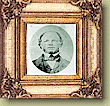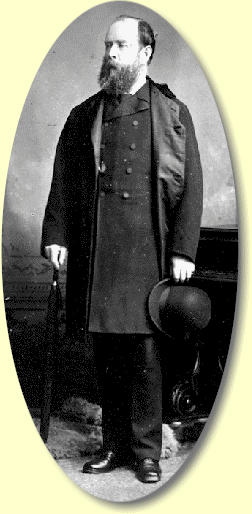

|
|
|
|
|
|
|
|
|
|
|
|
|
|
|
|
|
|
|
|
|
|
|
|
 |
JAMES MURRAY YALE, CHIEF TRADER AT FORT LANGLEY
Sir Joseph Trutch was a noted figure in the history of British Columbia, holding
many prestigious positions which enabled him to play a leading role in the shaping
of the young province. Born and raised in Ashcott, Summerset England in 1826,
Joseph Trutch was brother to Caroline, the wife of Peter O'Reilly. Trutch was
trained as a surveyor and civil engineer in Britain. He decided to leave from
Jamaica, where he lived with his father, to seek opportunity in the new world.
Trutch worked on contract as an engineer in the United States, first landing in
California the year of the 1849 gold rush, then working in Oregon, and Illinois. It
was there he fell in love with Julia Elizabeth Hyde, daughter-in-law to one of his
engineering partners. Trutch did not enjoy American life, so returned to England
with his bride.
In 1859, Trutch and his wife sailed to Victoria upon receiving a recommendation to Governor Douglas of British
Columbia to survey lots on the lower Fraser. Trutch proved himself an outstanding engineer. One of his most
challenging projects was as the private contractor responsible for the construction of sections of the Cariboo Road
to the Barkerville gold fields. This project involved building the rugged section of the road from Boston Bar to
Chapman's Bar. Perhaps Trutch's most noteworthy feat was the Alexandra Suspension Bridge, spanning the Fraser
river at Spuzzum. Many disillusioned gold prospectors found fair and reliable labour work on Trutch's crews. Trutch
also surveyed what is known today as Gastown in Vancouver.
With his sharp mind and passion for conservatism, Trutch forayed into colonial political life. After dabbling in local
by-elections, in 1864 Trutch was named by Governor Douglas to the position of chief commissioner of lands and
works for British Columbia. This position was not without its controversy. Through his previous contracts and
surveying experience, Trutch had managed to amass many lucrative land holdings and enterprises. The Alexandra
Suspension bridge contract allowed Trutch to collect seven years worth of tolls. This brought an income at an
estimated $10,000 to $20,000 a year. His political opponents feared that as Land Commissioner, Trutch would allow
many of the Portages on the Fraser River to become impassable, and all traffic would be forced to go through his
bridges, potentially tripling his income. Trutch was finally given the appointment on condition that he sell his
interests. Trutch was happy to oblige, as he had found a eager buyer - his brother John!
One of Trutch's most contentious legacies to B.C., and one the province still grapples with today, is that of his
Indian land policy. Douglas, Trutch's predecessor as chief commissioner of lands and works, had been the creator
of the Indian Land Policy. This policy saw an end to the practice of engaging Natives in signing treaties that would
extinguishing their land rights. Douglas did, however, see a role of assimilation for the native people within the
colony, and did attempt to take the interests of natives into account when laying out the reserves. At the least,
Douglas wished to provide the natives with a minimal economic base, and it was his wish that they be protected
from further encroachment.
Trutch, however, was noted for his disdain of the First Nations people of North America, and found their culture to
foreign and intolerable to his colonial and capitalist standards. Trutch felt the Indian land and culture should be
pushed aside for the white colonialists, believing that the natives had no valid claim to the land, therefore their was
no need for negotiating agreements compensation. Thus Trutch's Indian Land Policy of the 1860s saw not only a
confirmation in the policy of refusing to recognizing aboriginal title, but also of ensuring that Indian reserves were
of a minimal size.
Trutch felt the reserve area already given natives was much to generous in proportion to their population. He felt
also that those areas that contained good arable and grazing land should be given to white settlers. Reserves in the
Shushwap, Kamloops and Fraser Valley areas were the first of many to be down sized. Not only did native
opposition fall on deaf ears, but Trutch purposefully falsified Douglas's records in an attempt to justify the policy
change. In order to ensure his aboriginal policies were upheld, Trutch appointed his brother in law, Peter O'Reilly
as Indian Reserve Commissioner in the 1880s. Trutch's legacy of conflict and litigation surrounding Aboriginal
Land rights remains a controversial topic in British Columbia to this day.
Trutch's policy of usurping land from natives and giving it to developers and settlers only strengthened his
popularity amongst the colonies commercial and political elite. He became a member of the executive council, and
was a recognised spokesman for the commercial and transportation interests of the Lower Mainland, aiming to
attract the needed capital and labour to bring growth to the lumber, manufacturing and shipping industries. With his
reputation for effective speaking and keen intelligence, in 1870 Trutch was chosen as one of a delegation of three
(along with Dr. John Sebastian Helmcken and Dr, Robert William Weir Carrall) to represent the province in
negotiation talks between Ottawa and the BC Colonial government.
The biggest political issue of the day was whether the crown colony of B.C. should join Canadian confederation,
remain under the British Government, or become annexed to the United States. Trutch wanted to see a Canada
united from coast to coast, and played an impressive and leading role in securing Canada's entry into
Confederation in 1871. Prime Minister John A. Macdonad was so impressed with Trutch that he persuaded him to
become B.C.'s first Lietutenant-governer (from 1871 to 1876) after British Columbia became a province of Canada.
Trutch was a consummate Victorian gentleman, and he and his charming American wife Lady Julia Elizabeth were a
handsome and popular couple amongst the Victorian society, keeping a close knit community of powerful and
wealthy friends. Their gracious residence at 601 Trutch street was known as the "Trutch Estate" or "Fairfield
House", one of Victoria's social hubs. His sister Caroline resided there with him for a time, and it was there that
Trutch introduced her to his colleague and her future husband, Peter O'Reilly. Trutch's mother also came over
from England to live with Joseph at Fairfield House. She died the day after her granddaughter Mary Augusta
O'Reilly died, and they were buried the same day. Trutch's bother John also resided in Victoria, and his wife, Zoe
Musgrave, was the sister of Anthony Musgrave, the last colonial governor of British Columbia.
After leaving the Lieutenant-Governors position, Trutch returned to work in his business and engineering
enterprises. He retired in 1876, and was knighted by Queen Victoria in recognition of outstanding service to
Canada in 1889. Lady Trutch died at Fairfield House in 1895. Heartbroken, Trutch could not bear to live at his
home without his beloved wife, so he departed for Somerset, England, where he died in 1904. Trutch is
commemorated in the naming of two streets in his honour, one in Victoria, one in Vancouver.
Home| Contents| Tour| People| Collection| Transportation| Just For Kids!| Team
|
Last updated 31 August 1998. This digital collection was produced under contract to the SchoolNet Digital Collections Program, Industry Canada. Produced by Schoolnet Digital Collections Team. |

|